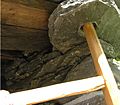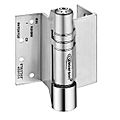Hinges facts for kids
A hinge is a cool mechanical part that connects two objects, usually allowing them to rotate or swing relative to each other. Think of a door opening and closing – that's a hinge at work! Hinges are super important because they let things move smoothly and stay connected at the same time.
They are made from different materials like metal, plastic, or even wood, and come in all shapes and sizes depending on what they're used for. From tiny jewelry boxes to huge bridge sections, hinges make movement possible everywhere!
Contents
How Hinges Work
Hinges work by having two parts, called "leaves" or "wings," that are connected by a central pin or pivot point. One part attaches to a fixed object, like a door frame, and the other attaches to the moving object, like the door itself. When the door moves, it rotates around the hinge's pin.
This simple design allows for a controlled swinging motion. The pin acts as the axis of rotation, making sure the door opens and closes in a predictable way. Without hinges, doors would just fall off or be stuck in one place!
Types of Hinges
There are many different kinds of hinges, each designed for specific jobs. Some are hidden, while others are meant to be seen. Let's explore a few common types.
Butt Hinges
A butt hinge is one of the most common types. It has two rectangular leaves that "butt" up against each other when closed. These leaves are joined by a pin. You'll often find them on doors in your home. They are strong and reliable for everyday use.
How Butt Hinges Are Used
Butt hinges are usually mortised, meaning a shallow cut is made in the edge of the door and the door frame. This allows the hinge leaves to sit flush, making the door close tightly. The number of loops on a butt hinge can vary. More loops can make the hinge stronger and more stable.
Barrel Hinges
A barrel hinge is a type of hinge where the two parts look like they have a barrel shape. These hinges are often used for heavier gates or doors. They are very strong and can support a lot of weight.
Barrel Hinge Design
Barrel hinges are usually made of strong metals like wrought iron or bronze. Their design helps distribute the weight evenly, making them very durable. You might see them on old, sturdy wooden doors or large outdoor gates.
Continuous Hinges
A continuous hinge, also known as a piano hinge, runs the entire length of the objects it connects. Imagine a piano lid – it uses a long hinge to support its whole length.
Benefits of Continuous Hinges
These hinges provide excellent support and distribute weight evenly along the entire edge. This makes them very strong and prevents warping. They are great for things that need a lot of support, like long cabinet doors or storage chests.
Living Hinges
A living hinge is different because it's not made of separate parts joined together. Instead, it's a thin, flexible piece of material that bends. It's often molded directly into plastic products.
Everyday Living Hinges
You see living hinges all the time without even realizing it! The lid of a Tic Tac box is a perfect example. The plastic itself is thin enough to bend repeatedly without breaking, acting as a hinge. This makes products cheaper to make and often more durable.
Specialty Hinges
Beyond the common types, there are many specialized hinges for unique purposes.
Spring Hinges
Some hinges have a spring inside that helps them close automatically. These are often used on screen doors or gates that need to swing shut on their own.
Swing Clear Hinges
Swing clear hinges are designed to move a door completely out of the doorway when opened. This creates a wider opening, which is helpful for moving large items or for accessibility.
Hinges in Other Devices
Hinges aren't just for doors! They are used in many other devices. For example, hinged handcuffs use a hinge to connect the two cuffs, allowing them to fold together. This makes them more rigid than chain handcuffs.
Where Do We Use Hinges?
Hinges are everywhere! They are essential for:
- Doors and windows: Allowing them to open and close.
- Cabinets and furniture: For cupboard doors, desks, and folding tables.
- Vehicles: On car doors, hoods, and trunks.
- Laptops: The screen connects to the keyboard with hinges.
- Tools and equipment: Many tools, like pliers or scissors, use a hinge-like pivot.
- Gates and fences: To allow entry and exit.
History of Hinges
Hinges have been around for a very long time! Early hinges were simple pivots made of wood or stone. Ancient civilizations used basic hinge designs for doors and gates. As metalworking improved, hinges became more complex and durable.
In ancient times, people used simple pivot hinges, sometimes just a stone or wooden peg fitting into a hole. Later, blacksmiths crafted hinges from iron, making them stronger and more secure. Over centuries, hinge designs have evolved, becoming more efficient and specialized for modern needs.
Images for kids
-
Old construction of hinges in a dry stone wall near Bignasco.
-
A living hinge on the lid of a Tic Tac box.
-
Hinged handcuffs
See also
 In Spanish: Bisagra para niños
In Spanish: Bisagra para niños

















